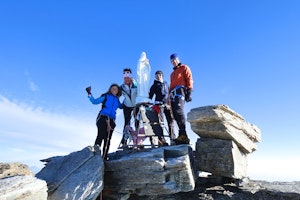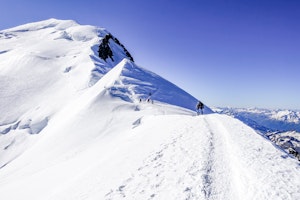When you own your breath, nobody can steal your peace.
The saying is so old that no one is sure who originally coined it. However, when heading out on a high altitude or polar adventure, the storied mantra serves us well.
Paradoxically, breathing is both an automatic reflex – something so easy that we can literally do it in our sleep – and an acquired skill. From singing opera to summiting the world’s highest mountains, practicing proper breathing techniques can be the difference between success and failure.
Before heading out to climb a 6,000-meter (19,700-foot) mountain or journeying to the top or bottom of the world, it is important to know proper breathing techniques in order to cope with the thin air and freezing temperatures.
Below we’ve compiled some useful information about the different types of breathing techniques and when to use them. Keep these in mind before heading out on your next extraordinary adventure!
Breathing Techniques

Practicing all types of different yoga or meditation techniques is a great way to improve your breathing. Photo courtesy of One Carioca Day.
While there are countless different types of breathing techniques aimed at achieving all sorts of goals, many stem from ancient breathing techniques such as Pranayama and Qigong.
Pranayama is the practice of controlled breathing in yoga and has its roots in traditional Hindu and Buddhist meditation practices.
There are approximately 50 different versions of the Pranayama technique, each of which has its own benefit. However, practicing the method generally improves blood circulation, concentration and allows for improved body temperature regulation, all of which are useful for a variety of extreme outdoor activities.
Qigong (pronounced “chee-guhng”) is a centuries-old breathing and meditation practice that originates in East Asia and focuses on making slow and deliberate movements that are coordinated with deep breathing exercises.
Due to its low impact on the body, Qigong is great exercise for those returning from an injury or looking for a low-impact way to strengthen muscles and tendons. It also promotes belly breathing, which is useful for a range of outdoor sports, such as trail running and cycling.
Modern techniques have developed and adapted many of these breathing practices to achieve different purposes that range from calming anxiety to all kinds of sports training.
The Wim Hof method, for example, championed by the Dutch extreme athlete Wim Hof – who is famous for feats such as swimming under ice and running half-marathons barefoot in the snow – focuses on breathing to help regulate the nervous system and control the body’s temperature. It is similar in style to Pranayama.
Breathing at High Altitudes

Climbing and camping at high altitude requires a different type of breathing to keep oxygen flowing steadily throughout your body. Photo courtesy of Central Asia Guides Bureau.
Prior to heading on any high-altitude mountain climbing trip, it is best to add some breathing exercises to your normal training routine.
At high altitudes, the air is colder, less dense and contains a lower concentration of oxygen molecules relative to carbon dioxide. Properly preparing to head into this type of environment will greatly increase your chances of success and enjoyment.
The Cleveland Clinic, a non-profit academic medical center, defines high altitude as 8,000 to 12,000 feet (2,438 to 3,658 meters); very high altitude as 12,000 to 18,000 feet (3,658 meters to 5,486 meters) and extremely high altitude as more than 18,000 feet or 5,486 meters.
You will feel the effects of altitude on your body at altitudes as low as 8,000 feet and will steadily be able to advance to higher altitudes with proper acclimatization, which a good guide will lead you through. At an altitude of 26,000 feet (7,925 meters), supplementary oxygen becomes necessary, regardless.
Expeditions to the Himalayas in Nepal, the Karakoram and the Hindu Kush, in Pakistan; the Kyrgyz Pamir Range; the Hengduan, in China; the Tian Shan; or the Alaska Range, all require sustained climbing at extremely high altitude.
Keep reading: An Unforgettable Himalaya Mountain Climbing Course
Undertaking several types of breathing exercises will train your lungs to make the most of the limited oxygen at higher altitudes and better prepare your body to cope with the side effects of taking in less oxygen.
Belly Breathing
The most basic, which is used in many sports and health practices, is diaphragmatic breathing, also known as abdominal or belly breathing. It facilitates a full oxygen exchange and can be easily trained at home.
Belly breathing is what we do when we are babies. In order to re-acclimate yourself to this type of inhalation, it takes some practice. To do so, you can lie down on your back with bent knees, place one hand on your chest and the other on your belly, and upon inhaling, instead of taking the air towards your chest, take it towards your stomach.
While this sensation may feel a bit strange at first, that is because you are using your entire lung capacity to breathe. This allows more oxygen to be pumped through the body, particularly to your extremities, and prevents the buildup of cramp-causing lactic acids.
Spend 5 to 10 minutes practicing this type of breathing each day until it becomes natural, especially right before undertaking physical activity.
The Pressure Breath
Once you’ve mastered the belly breath, you can add resistance to your exhalation by pursing your lips and exhaling forcefully, and this is what mountaineers call the Pressure Breath. This is one of the most important breaths for climbing at high altitudes and helps combat the decrease in atmospheric pressure.
Inspiratory Muscle Training
Inspiratory muscle training is another popular technique, which is a type of resistance training for the muscles that control air inhalation. One study out of Indiana University demonstrated that this type of exercise decreases the amount of oxygen that inspiratory muscles need to function. To practice it, you need to add external resistance to inhalation, which is most commonly done with an inspiratory muscle training device.
Breath-holding Drills
Breath-holding drills are another technique that can help you cope with high altitudes.
One of the best ways to prepare your body for this type of exertion (without moving to the mountains) is through simple breathing exercises, that should, however, be practiced with appropriate caution. A simple way to start is by inhaling to your maximum capacity, then holding for 3 counts, exhaling fully, and slowly increasing the counts as you progress.
Just about anyone who plans to climb the Seven Summits, head on a Himalayan mountaineering expedition or to the Andes Mountains will benefit from practicing these techniques prior to the trip.
Already planning to put some of these high altitude breathing tips to the test? Then try them out on a month-long Himalayan mountaineering course!
Breathing in Cold Weather

Sustained trips above the Arctic Circle mean spending plenty of time in the cold. Adopting the proper breathing techniques can help you better regulate your body temperature. Photo courtesy of Dixie Dansercoer.
Whether you plan on heading on a polar expedition or simply for a run on a winter day, learning the proper cold-weather breathing techniques can help improve your performance and your body’s ability to cope with the cold.
While “cold” is generally seen as a relative term, the Mayo Clinic recommends switching from outdoor to indoor activities once temperatures dip below 0 ºF (-18 ºC). However, for mountaineering trips, Arctic adventures and Antarctic expeditions, there is no indoor option.
Therefore, learning how to breathe best in below-freezing weather is another way to prepare for these harsh conditions and make the most out of what will surely be the trip of a lifetime.
Very cold air is also very dry, which is why hydration is also key for the respiratory system in extreme cold weather conditions.
Khapalabhati
In the 1980s, a study conducted on Indo-Tibetan Yogis in the Himalayas showed that they were able to increase the temperature of their fingers and toes by 46.9 ºF (8.3 °C) using breathing and meditation techniques.
Khapalabhati, also known as breath of fire or skull-shining breath, is a popular pranayama that raises body temperature and focuses on passive deep inhales and strong, energetic abdominal exhales. It requires a bit of practice to master this technique and has some counter-indications, so make sure it is adequate for you before trying at home.
Tummo Warming Breath
Tummo warming breath, an ancient Tibetan Buddhist technique that translates to “Inner Fire”, is another prana and meditation practice with visualizations to increase body temperatures.
It is one of the techniques that the aforementioned Wim Hof – aka the Iceman – who uses meditation and breathing exercises to regulate his own body temperature in extreme conditions, incorporates in his method. His techniques also focus on the activation of brown fat. Brown fat is a type of tissue that emits heat in mammals in extreme environments.
Try out some of these warming breathing techniques on this incredible Arctic circle trail ski expedition in Greenland!
Uphill Breathing and Long Distance Runs

Running in the mountains requires a very different skill set from running on the road. Photo courtesy of Marc Gallagher.
A common phenomenon for many first-time trail runners, cyclers and hikers is the feeling of running out of breath while ascending steeply. Many assume this just means they are out of shape and need to train harder. However, the problem may be a technical one instead of a fitness one.
When breathing becomes labored and erratic, a cardiovascular reflex is triggered by the body that restricts the flow of blood to the limbs. This, in turn, makes you expend more energy and effort to achieve the same movement that you were before.
Practicing belly breathing, the same that is used for high altitude breathing, and rhythmic breathing will help you utilize your entire lung capacity and avoid the pattern of shallow chest breathing that tends to come with a sedentary lifestyle.
Rhythmic Breathing
Rhythmic breathing means that you pay close attention to your breaths as you run or hike. Try to sync your inhales and exhales with your footsteps, consciously drawing in your breath for three steps before releasing it for the next two.
This 3:2 breathing pattern alternates which foot you are inhaling on as you run or hike, which helps more evenly distribute the impact of each landing across both sides of your body.
As with any exercise routine, start slowly until you get the hang of it and eventually it will become more natural.
Try trail running

Trails, such as the iconic GR20 in Corsica, have long been popular for hikers and are now becoming top trail running destinations as well. Photo courtesy of Caroline Freslon.
Both of these breathing practices are essential for trail running, which is skyrocketing in popularity, especially in France.
In a country with a long history of mountain sports, popular hiking trails are transforming into trail running destinations too. Both the Tour du Mont Blanc and Haute Route have moved from must-do hikes to top trail running destinations.
On the French-Mediterranean island of Corsica, the popular G20 trail has also become a favorite for trail runners.
Along with the familiar, trail running is also a way to see more exotic and lesser-traveled places as well. Crossing the Atlas Mountains in Morocco or the Andes Mountains in Patagonia, are also popular new trail running feats.
What are you waiting for? Why not try out some of these new breathing techniques before heading out on an Alpine trail running adventure!
Breathing is the most fundamental thing that we do as a species. While most people take their breath for granted, for those heading on a mountaineering trip or polar expedition, it is vital to re-visit this fundamental part of life.
Learning the proper breathing techniques will help you cope with the extreme cold of the poles or a mountain summit and allow you to make the most of the thin air at the world’s higher elevations.







